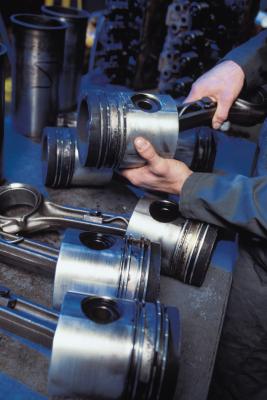
While they may not carry the cool factor of a big camshaft or trick cylinder heads, bushings are nonetheless vital players in terms of engine performance and longevity. And there are more than you might think, especially when you examine those individual components in engineering terms instead of just by name.
In technical terms, a "bushing" is a flexible isolator designed to absorb vibration, but it generally means something a bit different when you're talking about engines. In an engine, a bushing is indeed an isolator, but in this case it's more of a metal sleeve designed to keep moving components from wearing directly on other components. In this sense, the bushing actually functions more as a bearing. The difference is a subtle one, but bearings are typically used for components -- like the camshaft and crankshaft -- that constantly rotate, while bushings are used for reciprocating movements.
Another thing that separates bushings from bearings is that the bushing itself often acts as a sort of metal lubricant for the engine. As such, bushings need to be made of metals like bronze, which is almost as metallurgically "slippery" as copper, but is hard enough to withstand the rigors of an internal combustion engine. While most bushings use a standard bronze composed of copper and tin, copper-nickel alloys offer a bit more corrosion resistance with little to nothing given up in terms of strength and lubricity. This contrasts sharply with bearings, which often use a softer aluminum alloy that requires constant and heavy lubrication.
Because bushings are typically used for reciprocating -- back-and-forth -- movement, you'll find them most often in the valvetrain. You'll almost always find the pressed into the lifter bores of "pushrod" engines, keeping the lifters out of direct contact with the engine block. Valves need high-lubricity sleeves to keep them from binding in the cylinder head, because valves only get what lubricant sticks to them after they pass through the valve seals. You'll often find bushings pressed into the wristpin holes on pistons, allowing the pin to rotate or "float" in the pin bore.
Your engine's motor mounts are bushings in the standard sense of the word, in that they serve to isolate engine vibrations and keep them from snaking through the chassis and rattling your fillings out. Motor mounts typically consist of a pair of metal plates bonded together with rubber; holes cast into the rubber give it a bit more room to contract and expand. While they do a good job of isolating vibrations when new, rubber mounts will wear out over time, the rubber softening and tearing with constant heating and cooling cycles.
Believe it or not, your engine's harmonic balancer is, in fact, one kind of bushing. Harmonic balancers are functionally similar to motor mounts. They consist of a metal hub mounted to the nose of the crankshaft, a thick ring of rubber around the center hub and a heavy iron ring bound to the outer edge of the rubber ring. As minor vibrations work down your pistons and try to shake the crankshaft, the balancer cancels them out using the inertia of that heavy outer ring to resist rapid acceleration and deceleration of the crank. In this sense, the balancer stabilizes the crankshaft, keeping from reaching a point of harmonic resonance and snapping in two because of minor vibrations in the rotating assembly.